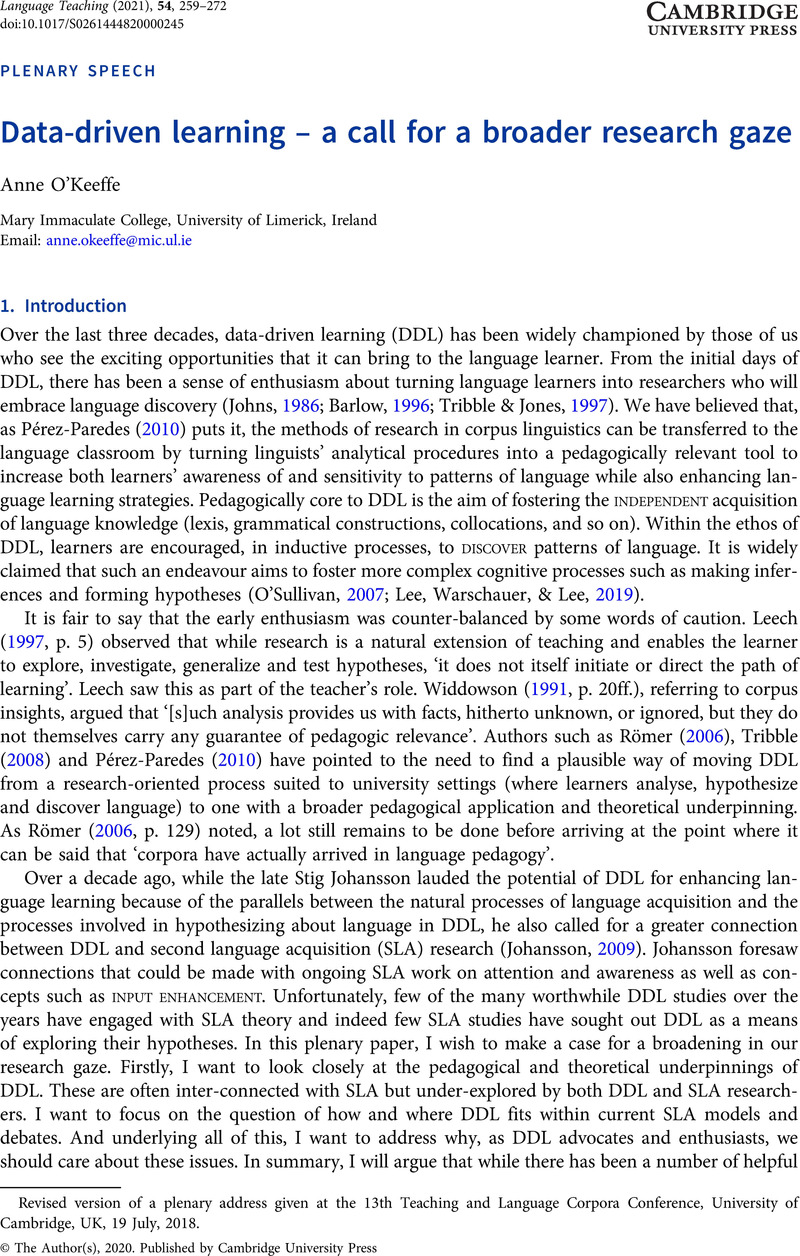Crossref Citations
This article has been cited by the following publications. This list is generated based on data provided by Crossref.
O'Keeffe, Anne
2021.
Beyond Concordance Lines.
Vol. 102,
Issue. ,
p.
35.
Zare, Javad
and
Aqajani Delavar, Khadijeh
2022.
Enhancing English learning materials with data-driven learning: a mixed-methods study of task motivation.
Journal of Multilingual and Multicultural Development,
p.
1.
Kotiurova, Irina
and
Trenina, Polina
2022.
Comparative Analysis of Automatic POS Taggers Applied to German Learner Texts.
p.
115.
Wulff, Stefanie
2022.
Some thoughts on the future of data-driven learning in research and instructional practice.
Pedagogical Linguistics,
Vol. 3,
Issue. 2,
p.
187.
Du, Hang
2022.
Grammatical and lexical development during study abroad: Research on a corpus of spoken L2 Chinese.
Foreign Language Annals,
Vol. 55,
Issue. 4,
p.
985.
Chen, Mei-Hua
2022.
Emerging Concepts in Technology-Enhanced Language Teaching and Learning.
p.
275.
O'Keeffe, Anne
and
Mark, Geraldine
2022.
Principled pattern curation to guide data-driven learning design.
Applied Corpus Linguistics,
Vol. 2,
Issue. 3,
p.
100028.
Teng, Lin Sophie
and
Pan, Jinyun
2022.
Book Review.
Journal of Second Language Writing,
Vol. 58,
Issue. ,
p.
100909.
Ueno, Shotaro
and
Takeuchi, Osamu
2023.
Effective corpus use in second language learning: A meta-analytic approach.
Applied Corpus Linguistics,
Vol. 3,
Issue. 3,
p.
100076.
Crosthwaite, Peter
Luciana
and
Wijaya, David
2023.
Exploring language teachers’ lesson planning for corpus-based language teaching: a focus on developing TPACK for corpora and DDL.
Computer Assisted Language Learning,
Vol. 36,
Issue. 7,
p.
1392.
Sato, Masatoshi
2023.
Metacognition and Data‐Driven Learning.
TESOL Quarterly,
Lusta, Amel
Demirel, Özcan
and
Mohammadzadeh, Behbood
2023.
Language corpus and data driven learning (DDL) in language classrooms: A systematic review.
Heliyon,
Vol. 9,
Issue. 12,
p.
e22731.
Mizumoto, Atsushi
2023.
Data-driven Learning Meets Generative AI: Introducing the Framework of Metacognitive Resource Use.
Applied Corpus Linguistics,
Vol. 3,
Issue. 3,
p.
100074.
Zare, Javad
and
Aqajani Delavar, Khadijeh
2023.
A Data-driven Learning Focus on Form Approach to Academic English Lecture Comprehension.
Applied Linguistics,
Vol. 44,
Issue. 3,
p.
485.
Boulton, Alex
and
Vyatkina, Nina
2023.
Expanding Methodological Approaches in DDL Research.
TESOL Quarterly,
Dong, Jihua
Zhao, Yanan
and
Buckingham, Louisa
2023.
Charting the landscape of data-driven learning using a bibliometric analysis.
ReCALL,
Vol. 35,
Issue. 3,
p.
339.
Li, Mengqi
and
Pan, Dongxia
2023.
Advances in Web-Based Learning – ICWL 2023.
Vol. 14409,
Issue. ,
p.
28.
Şahin Kızıl, Aysel
2023.
Data‐driven learning: English as a foreign language writing and complexity, accuracy and fluency measures.
Journal of Computer Assisted Learning,
Vol. 39,
Issue. 4,
p.
1382.
Liu, Tanjun
and
Chen, Meilin
2023.
An Investigation Into Learners’ Cognitive Processes in Data-Driven Learning: Case Studies of Six Learners of Chinese.
Chinese Journal of Applied Linguistics,
Vol. 46,
Issue. 4,
p.
544.
Crosthwaite, Peter
2023.
Pascual Pérez-Paredes and Geraldine Mark (eds.). Beyond concordance lines: Corpora in language education. Amsterdam/Philadelphia: John Benjamins Publishing Company, 2021. ix. 255 pp. ISBN: 978-9-02720989-4 (HB).
ICAME Journal,
Vol. 47,
Issue. 1,
p.
145.






